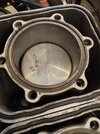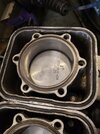jncandrews
New Member
1993 XP (657)
Reman crank
New RV shaft
Cylinders honed 30 over
New pistons/rings (30 over) installed
New rotary valve (minor scoring on RV cover, no grooves or depth to any of the scoring)
Complete gasket set
First time on water, jet ski ran fairly well for a few minutes. After about 10-15 minutes, loss of power above about a third throttle. Will start and idle fine.
Checked compression and only 70-80 in both cylinders.
Can scoring on the RV cover cause that much of a compression loss?
Is it possible the piston rings are installed incorrectly (ie, upside down)
Rechecked RV timing several times and it is where it should be.
Next thing I'm contemplating is pulling the jugs and seeing what is going in inside the cylinders.
No real great idea on what I should be doing at this point.
Thanks for any assistance.
Jeff
Reman crank
New RV shaft
Cylinders honed 30 over
New pistons/rings (30 over) installed
New rotary valve (minor scoring on RV cover, no grooves or depth to any of the scoring)
Complete gasket set
First time on water, jet ski ran fairly well for a few minutes. After about 10-15 minutes, loss of power above about a third throttle. Will start and idle fine.
Checked compression and only 70-80 in both cylinders.
Can scoring on the RV cover cause that much of a compression loss?
Is it possible the piston rings are installed incorrectly (ie, upside down)
Rechecked RV timing several times and it is where it should be.
Next thing I'm contemplating is pulling the jugs and seeing what is going in inside the cylinders.
No real great idea on what I should be doing at this point.
Thanks for any assistance.
Jeff





